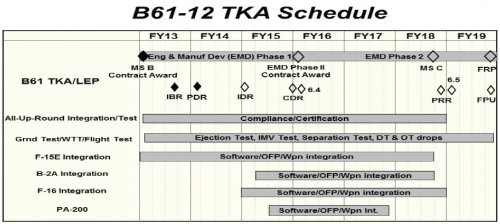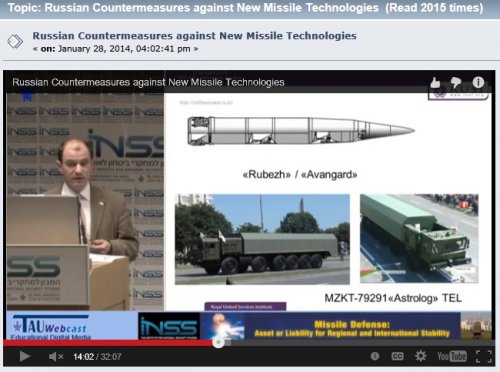Are Nuclear Weapons Getting a Smaller Slice of the U.S. Budget Pie?
March 3, 2014
By Douglas P. Guarino
Global Security Newswire
A B-52 bomber being prepared for refueling in 2002. The aircraft type has been in service since the 1950s, when nuclear weapons spending accounted for a larger percentage of the federal budget. A B-52 bomber being prepared for refueling in 2002. The aircraft type has been in service since the 1950s, when nuclear weapons spending accounted for a larger percentage of the federal budget. (Greg M. Kobashigawa/USAF/Getty Images) Has the percentage of U.S. federal budget dollars devoted to nuclear weapons activities declined in recent decades? The answer, generally speaking, is yes, but what that means and whether it matters depends on who you talk to. Sherman McCorkle cited the issue in an interview last month with Global Security Newswire. He leads a new Strategic Deterrent Coalition that is looking to convince Americans that maintaining existing nuclear weapons is essential to national security. McCorkle was asked to respond to growing concerns that an increasingly tight budget environment would make it impossible to follow through on the government's current plans for modernizing the nuclear arsenal. The James Martin Center for Nonproliferation Studies, for instance, released a report last month asserting the current plan would cost at least $1 trillion over the next 30 years and would be fiscally impossible to implement.
McCorkle, chairman and CEO of the Sandia Science & Technology Park Development Corporation, said he doesn't put too much stock in such studies. His company is located near the Energy Department's Sandia National Laboratories in New Mexico, which works on nuclear arsenal-related projects. "I think most people in America have learned over the last three or four decades that [for] anybody's point of view, there can be a study that would support that view," he said. "There are as many studies are there are points of view." McCorkle added that over time, nuclear arms have taken a shrinking portion of the federal budget pie. "If you track in cost and dollars going back to the 60s, 70s, 80s … the cost of the nuclear deterrent vis a vis the total defense budget or vis a vis the United States budget … is a smaller percentage now than it was then. … It's a decreasing amount of both our defense budget and our national budget." While exact figures on all nuclear weapons-related expenditures can be difficult to pin down, nuclear-weapons activities do generally account for a smaller percentage of the U.S. defense budget today than they did in past decades. For example, in 1962, the military's strategic forces budget was $10.6 billion, or about 22 percent of the Defense Department's total $48.4 billion budget that year, according to Defense budget documents. The now-defunct Atomic Energy Commission, meanwhile, spent roughly an additional $10 billion on nuclear warhead activities, according to Stephen Schwartz, editor of the James Martin Center for Nonproliferation Studies' Nonproliferation Review. This means that, in 1962, nuclear weapons spending amounted to more than $20 billion, or roughly 18 percent of a $106 billion federal budget that year. This was at the height of the Cold War, when the United States was building up its nuclear arsenal in competition with the Soviet Union, the world's other superpower. In 2012 -- more than two decades after the Cold War ended -- the strategic forces budget was $12.6 billion, less than 2 percent of the $652 billion in defense spending that year. The Energy Department spent an additional $16.8 billion, meaning total nuclear weapons spending amounted to about $29.4 billion -- roughly 0.8 percent of all federal expenditures. These numbers are far from a perfect representation of nuclear weapons costs however, budget experts say. For example, the strategic forces budget includes things like B-1 bomber aircraft, which can fly long distances but no longer carry nuclear weapons. It also includes B-52 bomber aircraft, some of which no longer carry nuclear weapons, and also four Ohio-class ballistic missile submarines that have been converted to conventional missions only.
Also, of the $16.8 billion the Energy Department spent on nuclear defense activities, only $7.2 billion were directly tied to the nuclear stockpile, said Schwartz. "The other costs are important and related in various ways to the nuclear stockpile and nuclear security generally, but in all but a few cases they are costs we would continue to bear even if we gave up nuclear weapons tomorrow," he said. On the other hand, the 2012 strategic forces spending figure excludes several key items, such as costs associated with nonstrategic nuclear weapons in the United States and Europe, and relevant intelligence operations. "If just 10 percent of the total current intelligence budget were allocated to the nuclear mission -- a figure that may well be too low based on historical precedent -- the nuclear weapons budget would increase by $7.5 billion," said Schwartz. However, "it is dramatically true" that the percentage of federal spending that nuclear-weapons activities account for is less than it once was, said Russell Rumbaugh, director of budgeting for foreign affairs and defense at the Stimson Center. This is "largely because the size of the U.S. budget has increased so much," he added.
Whether the reduced percentage of budget dollars spent on nuclear arms over time suggests that the sector should be spared any cuts in the years to come -- as McCorkle suggests -- is another question, however. Benjamin Loehrke, senior policy analyst for the Ploughshares Fund, argues that they do not. "I'm skeptical of what can be learned from such comparisons," Loehrke told GSN. "Of course the percentage is in relative decline. At the height of the Cold War, the nuclear arsenal was irrationally big and extremely expensive." According to Loehrke, the comparison "tells you nothing about how many nuclear weapons we need today and how much the U.S. should spend on them." Such "strategic questions are more relevant than Cold War budget nostalgia," he says. Schwartz notes that, in 1962, the United States had 25,540 operational warheads -- as opposed to 4,680 in 2012. "The percentage figures say very little about trends, actual amounts of spending, or decisionmakers' views of the overall importance of the program, or lack thereof, across time," he argued. "As the federal budget expanded with the cost of the Vietnam War, the Great Society, etc., the relative percentage of everything else -- including nuclear weapons -- shrank," said Schwartz. "It's entirely possible for actual nuclear weapons spending to go up even as its share of the federal budget -- or the overall DOD budget -- goes down." According to Schwartz, current Energy Department weapons spending is nearly $2 million more than the average annual expenditures for the same activities during the Cold War, when adjusted for inflation.
He offered an analogy. "If I make $100,000 a year and spend $5,000 annually on a home security system, it doesn't follow that if I get a new job that pays me $200,000 a year that I need to double what I spend on home security for the same house in order to maintain the same percentage to keep my family and possessions as safe as they were before I began earning more," Schwartz said.



